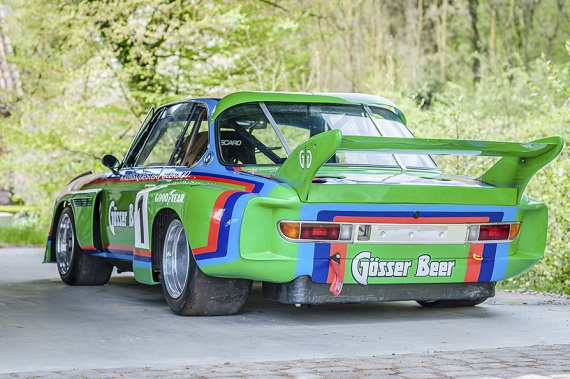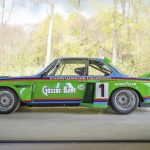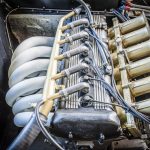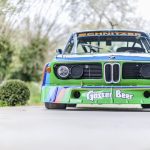While there are iconic liveries that permeate motorsports, sometimes there are equally iconic aerodynamic aids. The 1970s and 1980s saw some incredible experiments, from the Brabham BT46 ‘Fan Car’ which sucked all of the air out from underneath the chassis, literally sticking the car to the road to the 935/78 ‘Moby Dick’ car, which somewhere underneath the long tail and stretched front end was actually a 911 (in theory, at least!). For BMW, exploiting the Group 5 FIA rules to suit their E9 chassis and make it competitive with the Porsche 911. That meant the aerodynamics of the 3.0CS had to be altered, and the result was wings, fins, and flares. But if the road going version of the also lightened 3.0CSL looked outrageous, the racing version simply took the recipe and turned it up to 11. Giant boxed flares widened the E9 half again. A huge front air dam looked capable of clearing cattle on the Sante Fe railway. Huge centerlock BBS magnesium wheels sported a footprint that would make most large commercial planes jealous. And if the tires didn’t shock them, the huge cantilevered wing protruding from the back of the trunklid certainly would spoil their plans to go airborn. This was the legendary car which gained the name “Batmobile”, and though they were not ultimately able to defeat Porsche in the Group 5 contest for 1976 (you know that, of course, because of the many Martini Championship Edition Porsches we feature), they are no less memorable than the 935:
CLICK FOR DETAILS: 1975 BMW 3.5 CSL at Jan Luehn Cars
Year: 1976
Model: 3.5 CSL
Engine: 3.5 liter inline-6
Transmission: 5-speed manual
Mileage: N/A
Price: POA
1976 BMW 3.5 CSL Group 5 ‘Batmobile’
Ex-Works car, one of four factory built Group 5 cars
Chassis No
2275982Model history:
Introduced in May 1972, the 3.0 CSL was a homologation special built to make the car eligible for racing in the European Touring Car Championship. 1,265 were built.The “L” in the designation meant leicht (light), unlike in other BMW designations, where it meant lang (long). The lightness was achieved by using thinner steel to build the unit body, deleting the trim and soundproofing, using aluminium alloy doors, bonnet, and boot lid, and using Perspex side windows. Initially using the same engine as the 3.0 CS, the 3.0 CSL was given a very small increase in displacement to 3,003 cc by increasing the engine bore by one quarter of a millimetre. This was done in August 1972 to allow the CSL to be raced in the “over three litre” racing category, allowing for some increase in displacement in the racing cars. In 1973, the engine in the 3.0 CSL was given another, more substantial increase in displacement to 3,153 cc by increasing the stroke to 84 mm. This final version of the 3.0 CSL was homologated in July 1973 along with an aerodynamic package including a large air dam, short fins running along the front fenders, a spoiler above and behind the trailing edge of the roof, and a tall rear wing. The rear wings were not installed at the factory, but were left in the boot for installation after purchase. This was done because the wings were illegal for use on German roads. The full aero package earned the racing CSLs the nickname “Batmobile”.
In 1973, Toine Hezemans won the European Touring Car Championship in a 3.0 CSL and co-drove a 3.0 CSL with Dieter Quester to a class victory at Le Mans. Hezemans and Quester had driven to second place at the 1973 German Touring Car Grand Prix at Nürburgring, being beaten only by Chris Amon and Hans-Joachim Stuck in another 3.0 CSL. 3.0 CSLs would win the European Touring Car Championship again in every year from 1975 to 1979. The 3.0 CSL was raced in the IMSA GT Championship in 1975, with Sam Posey, Brian Redman, and Ronnie Peterson winning races during the season.
The first two BMW Art Cars were 3.0 CSLs; the first was painted by Alexander Calder and the second by Frank Stella.
The 3.5 CSL was built for Group 5 racing and BMW won three races in the 1976 World Championship for Makes with this model.
Specific history of this car:
This specific car competed as a Works car in World Championship of Makes (Group 5) in 1976 and is one of only 4 cars built by the factory to Group 5 specification. As all BMW racing cars of that time it was entered by Schnitzer Motorsport for the factory. It is fixed with its matching numbers 480-bhp 24 valve 3.5 litre engine.Results in World Championship in 1976:
• 21 March, Mugello, Italy, with Dieter Quester/Albrecht Krebs/Brian Redman – DNF
• 4 April, Vallelunga, Italy, with Dieter Quester/Albrecht Krebs – DNF
• 9 May, Silverstone, Great Britain, with Dieter Quester/Albrecht/Krebs – DNF
• 30 May, ADAC 1000km Nürburgring, Germany, with Dieter Quester / Albrecht Krebs – 1st position
• 27 June, Österreich 1000km, Austria, with Dieter Quester / Nilsson – 1st position
• 10 July, Watkins Glen, USA, with Ronnie Peterson – 5th position
• 4 September, 6 hours of Dijon, France, with Dieter Quester / Albrecht Krebs / Ronnie Peterson – 6th position
• 12/13 July, 24 hours of Le Mans, France, with Dieter Quester / Albrecht Krebs / Alain Peltier – DNF whilst in 8th position
With this results, it was the most successful BMW in the 1976 championship resulting in BMW being 2nd overall in World Championship, only beaten by the Works Porsche 935. It is also the only BMW to be driven in period by two Formula 1 drivers, Ronnie Peterson and Gunner Nilsson.
For the 1977 season, Sepp Manhalter drove the car for the Memphis Racing Team in local races in Austria, Germany and Czechoslovakia.
By the end of 1977, the BMW was purchased by an Indonesian businessman and taken to Jakarta, were it won the Indonesian GP under the Bentol livery.
During 1978 the car was raced in Asia before developing an engine problem and being place in a shed and left until discovered by current owner in 2002. The car was brought back to UK and restored to perfection by marquee specialists with the assistance of BMW Motorsport. No crash damage was found and the car was in amazing original condition throughout, still carrying all the user rare BMW Motorsport pieces.
*2275982* has now been completely restored back to original condition with the engine, the gearbox and differential all being the car’s original units.
Of the 4 factory built cars only there are remaining (one is the World famous BMW Calder Art Car). Only two cars are in running order and this car is the only one which has still its original engine fitted!
This amazing BMW 3.5 CSL Group 5 car is now for sale for the first time since moe than a decade. It will be sold in fully race prepared condition and comes with a large history file. A truly unique opportunity to purchase a highly eligible piece of BMW racing history.
While the bright green over M Stripes Schnitzer livery might not be quite as notable as either the standard BMW Motorsports white with stripes, or indeed the Calder Art Car, it’s one eye catching color combination. Condition throughout is great as you’d expect from a refreshed car that hold both significant historical value and enthusiast appeal. With full history including race results with famous drivers, this is about as impressive as a racing BMW comes to market. The price? Well, we’ll have to speculate on that it will be expensive – I’d guess as high as a million dollars, if not more, given the attention levied on properly sorted historical race cars. For the rest of us, then, we can just dream we’re Hans Stuck launched the Batmobile towards the sky at Flugplatz…
-Carter











::drooling::